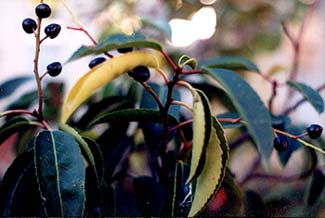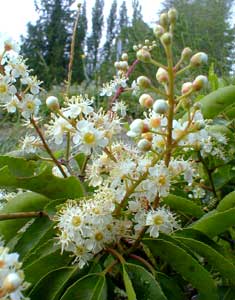
Portugal Laurel,
aka Portuguese Cherry Laurel,
aka Evergreen Bay-Tree,
aka Portugal Cypress
"He that planteth a tree is a servant of God."
-Henry van Dyke
(1852-1933)
(1852-1933)
For the first two years our Portugal Laurel (Prunus lusitanica) grew in a large kilned pot. Eventually it went into an area out by the road, near a low-maintenance garden of rugosa & sunroses & lavenders, for it is a heat- & sun-tolerant tree that needs little watering once it is well established. They're hard to kill, but it can be done with poorly draining soil, as Porgugal Laurel will not tolerate wet feet. It's otherwise highly adaptable in moist or droughty conditions, preferring lots of sun but getting by in part shade.
 Portugal Laurel is actually a cherry, not a true laurel. Unlike other cherries it is evergreen in the manner of laurel, & the leaves though shaped perfectly like plum leaves are tough & leathery also in the manner of laurels. Portugal Laurels additionally do not bloom until after new young leaves form in spring (among the previous year's unfallen leaves), whereas most plums & cherries bloom before leafing. Being so laurel-like in all these qualities, it has long been dubbed a laurel.
Portugal Laurel is actually a cherry, not a true laurel. Unlike other cherries it is evergreen in the manner of laurel, & the leaves though shaped perfectly like plum leaves are tough & leathery also in the manner of laurels. Portugal Laurels additionally do not bloom until after new young leaves form in spring (among the previous year's unfallen leaves), whereas most plums & cherries bloom before leafing. Being so laurel-like in all these qualities, it has long been dubbed a laurel.Portugal Laurels are frequently hedged or pruned for stunted growth to eight feet tall, but that is a terrible abuse of a potentially gorgeous tree. It wants to grow to 25 feet of height, & at least as wide. In the wild they can reach 50 feet, but cultivated specimens scarsely ever reach 30 feet.
When hedged they rarely fruit or flower, but permitted to grow into a respectable cherry tree, they will have a profusion of gorgeous five to ten inch racemes, as shown in the late May (2004) portrait second on this page. These are followed by small purple-red cherries that ripen to shiny black by autumn, as seen in the first October (2002) photo. For more photos of the fruit, see the Portugese Laurel page of the Pomes & Berries Gallery.
The small black cherries resemble choke cherry fruits & just like choke cherries are inaccurately regarded as toxic, or have been mistaken for toxic because true laurels are toxic. Portugal Laurels in fact produce edible berries, though to say they are not very flavorful unless cooked is understatement.
I tried to eat exactly one small cherry after it was newly ripened to black, & it tasted positively hideous. I spat & spat then ran in the house to gargle & rinse the horrid flavor out of my mouth. But if they are cooked & seived & sweetened for jelly or syrup, they would be as good as any bitter fruit can be.
Probably even the seeds are no longer toxic when the fruit is fully ripened, but to be on the side of caution the fruit should not be harvested until completely ripened to full blackness (by October) then should be cooked with the seeds carefully strained out.
Few people bother to harvest Portugal laurel cherries, which are left on the branches as bird-attractants in autumn & winter. The cherries are not eaten by birds until fully ripened. Because the leaves as well as the unripe seeds do contain cyanide, leaves should not be burned, or will release toxins to the atmosphere.
The shiny bright green foliage on red stems gains a bluish tinge in winter, as can be seen in the October photo. Left completely untrained, it becomes an enormous multi-stemmed bush, but is easily taught to grow from one leader, ideally with two or three branchings a little ways up the trunk for a forked trunk.
Originating in Spain & Portugal (its species name is an old name for Portugal), this tree has been gardened in England since the Elizabethan Age, long enough for it to have invaded some woodland areas to the detriment of native species. It has medicinal value, an extract of P. lusitanica having been used as bacteriocide & fungicide.